
Senecio is a genus of flowering plants in the daisy family (Asteraceae) that includes ragworts and groundsels.

Callirhoe is a genus of flowering plants in the mallow family, Malvaceae. Its nine species are commonly known as poppy mallows and all are native to the prairies and grasslands of North America. Of the nine species, some are annuals while others are perennial plants.

Sesbania is a genus of flowering plants in the pea family, Fabaceae, and the only genus found in tribe Sesbanieae. Riverhemp is a common name for plants in this genus. Notable species include the rattlebox, spiny sesbania, and Sesbania sesban, which is used in cooking. Plants of this genus, some of which are aquatic, can be used in alley cropping to increase the soil's nitrogen content. The species of rhizobia responsible for nitrogen fixation in Sesbania rostrata is Azorhizobium caulinodans.

Malvaviscus is a genus of flowering plants in the mallow family, Malvaceae. Common names for species in this genus include Turk's cap mallow, wax mallow, sleeping hibiscus, and mazapan. It belongs to a group of genera that differ from the closely related Hibiscus in possessing a fruit divided into 5 separate parts, and having a style surmounted by 10, rather than 5, capitate or capitellate stigmas. Among those genera Malvaviscus is distinguished by having auriculate petals and red, fleshy fruits. The generic name is derived from the Latin words malva, meaning "mallow," and viscus, which means "sticky," referring to the mucilaginous sap produced by members of the genus. The fruit can be used to make jelly or syrup. Both the fruit and flowers are used to make herbal teas.

Schinus is a genus of flowering trees and tall shrubs in the sumac family, Anacardiaceae. Members of the genus are commonly known as pepper trees. The Peruvian pepper tree is the source of the spice known as pink peppercorns. Some species have become an invasive species outside their natural habitats. Schinus polygama, although less well known, is also potentially weedy in mesic areas.

Parkinsonia, also Cercidium, is a genus of flowering plants in the pea family, Fabaceae. It contains about 12 species that are native to semi-desert regions of Africa and the Americas. The name of the genus honors English apothecary and botanist John Parkinson (1567–1650).
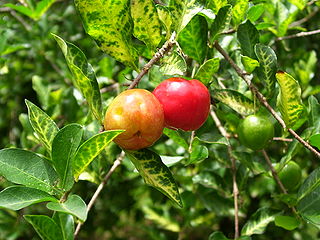
Malpighia is a genus of flowering plants in the nance family, Malpighiaceae. It contains about 45 species of shrubs or small trees, all of which are native to the American tropics. The generic name honours Marcello Malpighi, a 17th-century Italian physician and botanist. The species grow to 1–6 m (3.3–19.7 ft) tall, with a dense, often thorny crown. The leaves are evergreen, simple, 0.5–15 cm (0.20–5.91 in) long, with an entire or serrated margin. The flowers are solitary or in umbels of two to several together, each flower 1–2 cm (0.39–0.79 in) diameter, with five white, pink, red, or purple petals. The fruit is a red, orange, or purple drupe, containing two or three hard seeds. M. emarginata is cultivated for its sweet and juicy fruits, which are very rich in vitamin C.

Dichondra is a small genus of flowering plants in the morning glory family, Convolvulaceae. They are prostrate, perennial, herbaceous plants, with creeping stems which take root readily at the leaf nodes. The flowers are white, greenish or yellowish, 2–3 mm diameter. Members of the genus are commonly known as ponysfoots and are native to tropical and cool temperate regions around the world.

Colubrina is a genus of about 30 species of flowering plants in the family Rhamnaceae, native to warm temperate to tropical regions of Africa, the Americas, southern Asia, northern Australia, and the Indian Ocean islands. Common names include nakedwood, snakewood, greenheart and hogplum. The generic name is derived from the Latin word coluber, meaning "snake", and refers to the snake-like stems or stamens.
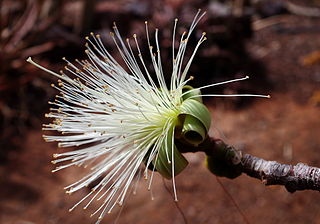
Pseudobombax is a genus of flowering plants in the subfamily Bombacoideae of the family Malvaceae.
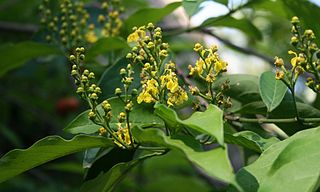
Bunchosia is a genus in the Malpighiaceae, a family of about 75 genera of flowering plants in the order Malpighiales. It contains roughly 75 species of trees and shrubs, which are native to dry woodlands, savannas, and wet forests. Their range extends from Mexico and the Caribbean to southeastern Brazil and adjacent Argentina. Bunchosia is one of three arborescent genera of Malpighiaceae with fleshy, bird-dispersed fruits.
Helietta is a genus of flowering plants in the citrus family, Rutaceae. Members of the genus are commonly known as barettas, barretas, or barrettas. The generic name honors French physician Louis Théodore Hélie (1802–1867).

Tiquilia is a genus of flowering plants in the borage family, Boraginaceae. The 27 species in this genus are known by the common name crinklemat. They are native to the Western Hemisphere and are mostly found in desert regions.

Bursera microphylla, known by the common name elephant tree in English or 'torote' in Spanish, is a tree in genus Bursera. It grows into a distinctive sculptural form, with a thickened, water-storing or caudiciform trunk. It is found in the southwestern United States and northwestern Mexico.
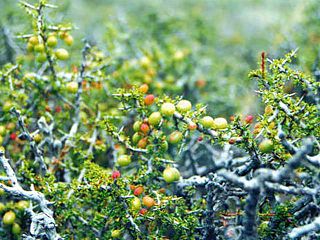
Condalia microphylla is a perennial shrub of the family Rhamnaceae endemic to Argentina.

Tithonia is a genus of flowering plants in the tribe Heliantheae within the family Asteraceae.

Porlieria is a genus of flowering plants in the caltrop family, Zygophyllaceae. Species within this genus are shrubs or small trees of dry subtropical regions. The generic name honours Spanish ambassador Don Antonio Porlier de Baxamar.

Ehretia is a genus of flowering plants in the borage family, Boraginaceae. It contains about 50 species. The generic name honors German botanical illustrator Georg Dionysius Ehret (1708–1770).
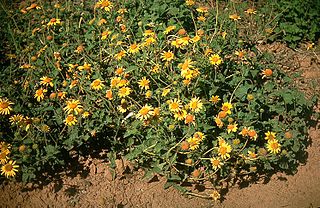
Simsia is a genus of flowering plants in the tribe Heliantheae within the family Asteraceae. It includes annuals, herbaceous perennials, and shrubs. They range from the western United States south through Central and South America to Argentina, with the center of diversity occurring in Mexico. The genus is named for British physician and botanist John Sims (1749–1831). Although some species are relatively rare, others have become common weeds that line the roadsides and fields of Mexico, often forming dense stands mixed with Tithonia and other Asteraceae. Some species are known by the common name bushsunflower.
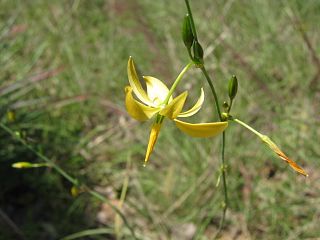
Echeandia is a genus of New World plants in the century plant subfamily within the asparagus family.



















